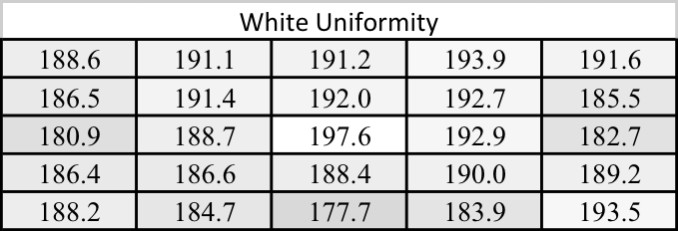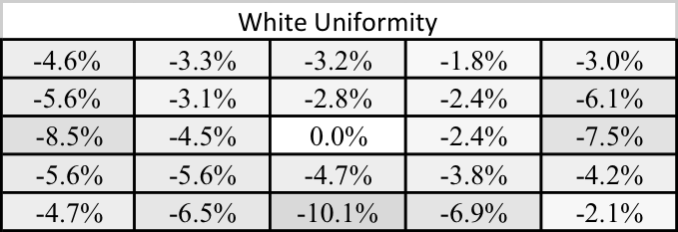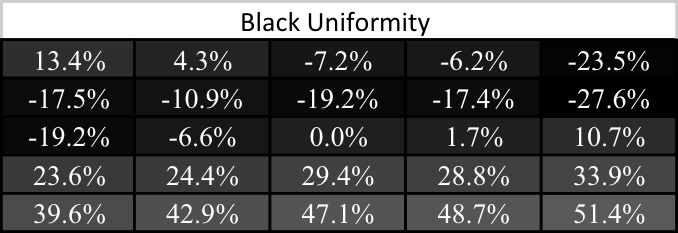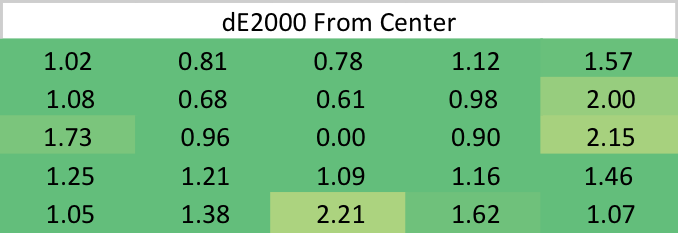The 9.7" iPad Pro Review
by Brandon Chester on June 1, 2016 9:00 AM ESTDisplay Uniformity
With Apple billing the 9.7" iPad Pro as a professional device with individually calibrated displays, I felt it was relevant to bring our uniformity test over to mobile. While we usually just measure errors at the center of a display, there are also errors across the panel itself due to inconsistencies in the panel and the backlighting array. This means that a display can be accurate at the center, but the edges can have significant luminance dropoff or gain that makes the display unsuitable for any sort of image work due to the fact that there are visible color differences across the display itself. For this test we use an array of 25 points on the display and measure the accuracy of colors in the GretagMacbeth ColorChecker test, as well as the uniformity of the white and black levels at each spot.
While I don't have any other mobile devices for reference, if I were evaluating the 9.7" iPad Pro as a professional monitor I would say that the white uniformity is decent, but not amazing in any regard. The central area of the display is fairly uniform, but there's noticeable dropoff on the left, right, and bottom edges. This is something I see on a number of phones and tablets, and maintaining uniformity probably hasn't been a concern for vendors until this point, but I'm hoping that a larger focus on it will make companies put more focus on it as a selling point for professional devices.
Black uniformity on the 9.7" iPad Pro isn't great. If you divide the display along its diagonal from the top right to bottom left corners you see that the in general the bottom section has higher black levels, while the top has lower black levels. In general, the black level isn't as dark at the edges as it is in the center. Black levels and contrast are the areas where Apple's LCDs really can't compete with Samsung's AMOLEDs, and with the 9.7" iPad Pro falling pretty far behind its bigger brother with black levels Apple should put more focus on at least keeping their blacks consistent across the display.
While the black uniformity isn't great on the 9.7" iPad Pro, and the white uniformity is just okay, the uniformity for colors is outstanding. There are a few hot spots on the edges, but in general the error relative to the center is well under two, and often near or even below one. I'm surprised that Apple has such uniform color rendition, as an uneven luminance level will usually throw off colors much more severely. Whatever the case may be, you can at least depend on even color rendering across the 9.7" iPad Pro's display.















144 Comments
View All Comments
Shadowmaster625 - Wednesday, June 1, 2016 - link
So this thing really does outscore AMD's top end FX-9590 in kraken 1.1?bernstein - Wednesday, June 1, 2016 - link
very interesting! in other words: it's almost half the speed of intel's top end i7 6700K in kraken 1.1......but in WebXPRT it's 200 vs. 3000 points...
So what's the more realistic results?
bernstein - Wednesday, June 1, 2016 - link
i7 6700K: http://www.anandtech.com/show/9483/intel-skylake-r...tuxRoller - Wednesday, June 1, 2016 - link
That score of 3000 is..I don't know, but a 2015 xps 15 scores around 440.So, about twice as fast as the Apple soc, but with better process, higher power budget and much larger tdp (given that it's in a full size laptop).
Stoked
Apple's doing an amazing job with their cpus. If they actually spent the die budget to enable smt they'd be right up there with core m.
tuxRoller - Wednesday, June 1, 2016 - link
http://principledtechnologies.com/benchmarkxprt/we...michael2k - Wednesday, June 1, 2016 - link
More interesting to compare it to ahttp://www.anandtech.com/show/10000/who-controls-u...
Carrizo is essentially Atom class and it's predecessor, Kavari, is found inside the PS4 and XB1, albeit with a more powerful GPU and an additional 4 cores. So if you can imagine a 4W processor competing with a 65W CPU:
http://www.anandtech.com/show/10000/who-controls-u...
That leaves about 50W for Apple to integrate, say, a Pascal GPU if they really wanted to create something incredibly powerful.
mdriftmeyer - Wednesday, June 1, 2016 - link
You are high if you compare a 4 core Excavator to an Atom.255BB - Thursday, June 2, 2016 - link
PS4 and Xbox one use Kabini not Kaveri. A 4 cores Kabini has a 15W TDP.Carrizo is not an Atom class .Its TDP is 15-35W (Carrizo-L is Atom class)
Meteor2 - Thursday, June 2, 2016 - link
Perhaps the same *performance* class. Not power class.michael2k - Thursday, June 2, 2016 - link
Right. So take a 4W SoC that currently has two cores and bump it up to 8. An A9X at 2GHz and 8 cores might take 15W. Throw in a Pascal GPU and now you're 35W, or 65W, depending on compute cores.On single thread performance we see the A9 is between Atom and Core at the same clock. That means it is also at the same performance level as Kaveri and Kabini.